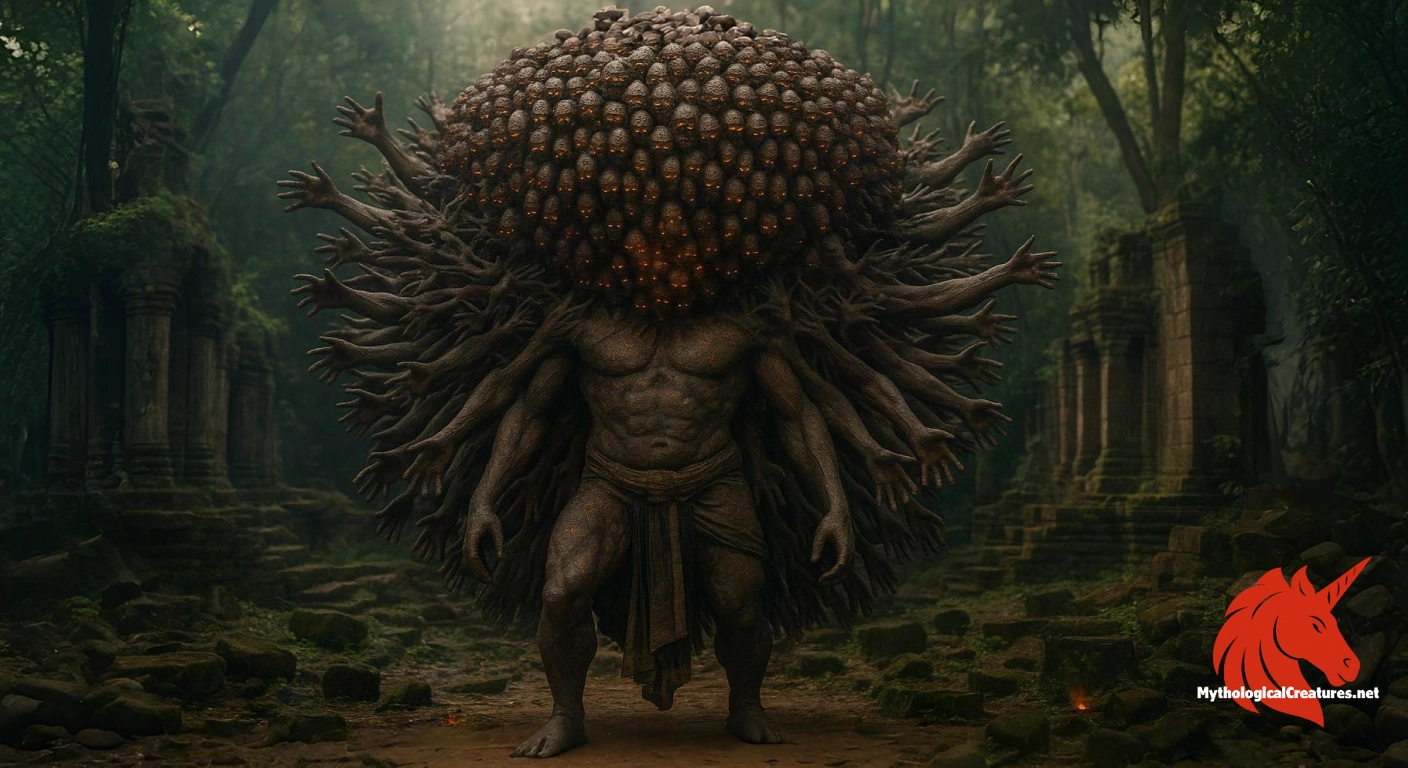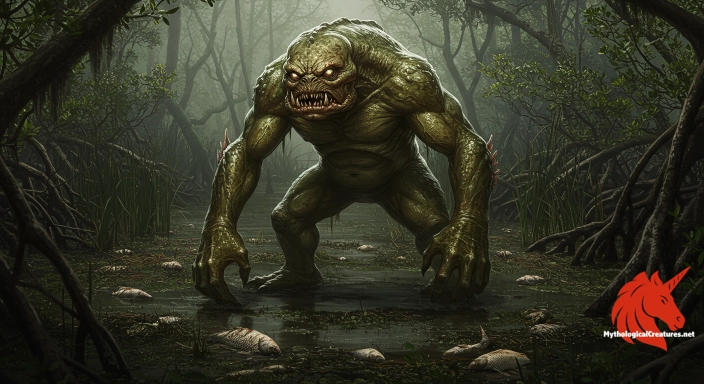Andhaka: Andhaka is a fearsome, malevolent asura from Hindu mythology known for his monstrous form that includes 1000 heads and arms.

Andhaka
Andhaka - Andhaka serves as a cautionary tale of pride and the destructive consequences of unchecked ambition.
Origins & First Encounters
Andhaka emerges as one of the most formidable and enigmatic figures in Hindu mythology, known for his association with darkness and chaos. His very name, meaning 'He who darkens', encapsulates the essence of his destructive character. Rooted in ancient puranic literature, Andhaka is portrayed as a malevolent asura whose overwhelming pride and ambition ultimately bring about his downfall. His origins are intriguingly complex, with some narratives naming him as a direct descendant of the divine couple Shiva and Parvati, which adds layers of irony and moral ambiguity to his story. The earliest attestations of his legend appear in texts that explore the eternal conflict between order and chaos. His myth functions as a potent reminder of the dangers of unchecked hubris, drawing audiences into a narrative that is both morally instructive and dramatically compelling. Audiences of early Hindu traditions would have recognised in him the embodiment of dark passions that, if not controlled, could lead to catastrophic disruption. Over time, his tale has been interwoven with broader themes of cosmic balance and transformation, ensuring his lasting place in the mythological canon. His story continues to evoke deep reflections on the nature of power and the consequences of pride.
Source Texts & Tale Variants
The story of Andhaka is recounted in a number of seminal texts, each offering its own variant on the asura’s dramatic life. Ancient puranas such as the Matsya Purāṇa, Kurma Purāṇa, Linga Purāṇa, Padma Purāṇa, and Shiva Purāṇa form the backbone of his mythological tradition. These texts present a range of narratives that explore both his origins and his tumultuous encounters with divine forces. In some accounts, a familial link with Shiva and Parvati is suggested, adding a profound twist to his character as both a scion of divinity and an agent of destruction. Other versions focus on the sheer force of his personality and his relentless pursuit to assert dominance over cosmic order. The multiplicity of these sources highlights the dynamic nature of myth-making and the different interpretative angles embraced by medieval storytellers. Each narrative formulation contributes distinctive details, emphasising aspects of brutality, cunning, and tragic destiny. While the core story remains the conflict between his overwhelming pride and divine retribution, regional and textual differences lend a rich diversity to his legend. Such variance in his depiction underscores the enduring impact of his myth in the collective cultural memory.
Form & Powers
Andhaka’s physical form is described with such grandiosity that it leaves an indelible impression on the reader’s imagination. He is most famously depicted as having one thousand heads, a detail that symbolises the multifaceted nature of his malevolence. In many renditions of his myth, his body is further adorned with one thousand arms and an astonishing two thousand eyes, each radiating a sinister vitality. Alternate versions even recount that he possesses two thousand arms and legs, enhancing the image of a behemoth whose very presence distorts normal notions of physicality. His enormous stature is not merely a matter of size, but a visual metaphor for the chaos and overwhelming power that he embodies. The countless eyes scattered across his form suggest a perverse omniscience, one that mirrors the all-encompassing nature of darkness. His shifting, fluid anatomy allows him to be agile and unpredictable in the face of divine opposition. This detailed depiction serves to accentuate the terror he inspires, making his battles with the gods appear both epic and climactic. Every aspect of his form—from his numerous heads to his sprawling limbs—reinforces the theme of uncontrolled energy turned against cosmic order.
Regional Faces
Across the vast cultural landscape of Hindu tradition, the figure of Andhaka is subject to a rich array of local interpretations and adaptations. In many regions, his tale is not solely seen as a narrative of demonic downfall, but also as a cautionary exemplar of the perils inherent in unchecked ambition and desire. In some southern traditions, his portrayal embraces an almost tragic dimension, suggesting that his origins may carry the hallmarks of both divine potential and inherent malevolence. Northern narratives, by contrast, often emphasise his fearsome physical features and the overwhelming, monstrous scale of his being. Such regional variations might also highlight differing aspects of his family ties, with some local lore asserting a direct lineage from Shiva and Parvati while others cast his birth in a more sinister light. Local festivals and temple traditions sometimes incorporate dramatizations of his defeat, using the myth as a vehicle for teaching moral lessons about the dangers of hubris. The adaptability of his story across various linguistic and geographic boundaries underscores its powerful symbolic appeal. Through these regional lenses, Andhaka becomes a multifaceted symbol whose myth continues to resonate with diverse audiences and reflect the varied values of different communities.
Cultural Parallels
The portrayal of Andhaka invites intriguing comparisons with other mythological figures both within and beyond Hindu culture. His depiction as a multi-headed, multi-limbed behemoth provides a strong visual and thematic parallel to entities like the Greek Hydra, whose numerous heads symbolise the inescapable nature of chaos. Similar to the narratives surrounding figures such as Ravana and Mahishasura, his story centres on the timeless conflict between the forces of unchecked power and the corrective influence of divine order. Andhaka’s tragic fall, driven by his overwhelming pride and ambition, echoes universal themes found in various mythologies where colossal beings ultimately succumb to higher cosmic principles. The motif of a monstrous adversary whose physical form is as multiple as his vices appears in numerous cultural traditions, illustrating a shared human preoccupation with the idea of internal and external darkness. His legacy is not isolated; rather, it interweaves with a broader tapestry of global myth, where heroes confront titanic forces embodying both natural and metaphysical chaos. These cross-cultural comparisons serve to highlight the enduring appeal of narratives that explore the limits of power and the inevitable triumph of order over entropy. Ultimately, Andhaka stands as a powerful allegory of the hubris that has captivated imaginations across civilizations, linking disparate mythic traditions through shared symbolic language.
Legacy & Modern Evolution
Over the centuries, the myth of Andhaka has undergone a fascinating evolution, mirroring shifts in cultural, religious, and artistic sensibilities. His initial portrayal as a fearsome demon was emblematic of a world where chaos and disorder needed to be confronted head-on by divine forces. As time progressed, interpreters of the myth began to see him not merely as a symbol of external darkness, but as an embodiment of the inner conflicts that exist within every individual. This nuanced view allowed for reinterpretations of his character in both medieval temple iconography and modern artistic expression. In the realm of visual arts, his monstrous form has frequently been depicted in intricate murals and temple sculptures, where his downfall is celebrated as a victory of order over blind ambition. Contemporary retellings in literature and digital media often cast him as emblematic of the perennial struggle between the shadow self and the enlightened spirit. His enduring legacy as a cautionary tale against overweening pride continues to inspire moral and philosophical discussions. In academic and cultural circles alike, Andhaka stands as a reminder of the complex interplay between divinity and human frailty. Modern adaptations of his story continue to find resonance among those who seek to understand the balance between power, responsibility, and the inner journey toward self-discovery.
Interesting Fact
An interesting aspect of Andhaka's myth is that, despite his fearsome reputation, some versions of his story suggest a complex character whose downfall was precipitated by his overwhelming pride, offering a nuanced view of the asura archetype.
Quick Creature Info
Features:
Associations:
Our Mythic Legendary Rating:

Habitat:
Supernatural Powers:
Physical Attributes:
Abilities:
Behavior:
Weaknesses:
Lore:
Related Creatures, Tales or Lore
- MMahishasura
- HHiranyakashipu
- RRavana
References
Discover Another Mythical Legend You May Not Have Heard Of?
Uncover the mysteries of ancient folklore and expand your knowledge of legendary beings from cultures around the world.
Dare to Meet the Berberoka....
Mythical Disclaimer: The images and data on this site are derived from various historical and literary sources, but we have found that many myths often have multiple versions and interpretations across references, sometimes contradictory. As a result, these creature depictions are artistic interpretations—imaginative blends of folklore, legend, and a dash of AI guesswork. Because creature descriptions vary widely, our illustrations and accompanying information represent our best effort to honor mythology while bridging creative gaps. Enjoy these interpretations—just remember, we've done our best to respect the stories and validate available data, but in the realm of mythology, details often shift, imagination leads the way, and nothing is ever set in stone!
Curated by the Mythological Creatures Team (rev. May 2025)
